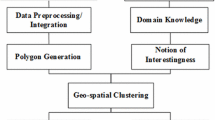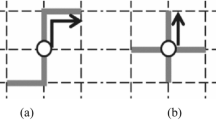Abstract
This chapter reviews a dynamic programming scan approach to the detection and inference of arbitrarily shaped spatial clusters in aggregated geographical area maps, which is formulated here as a classic knapsack problem. A polynomial algorithm based on constrained dynamic programming is proposed, the spatial clusters detection dynamic scan. It minimizes a bi-objective vector function, finding a collection of Pareto optimal solutions. The dynamic programming algorithm is adapted to consider geographical proximity between areas, thus allowing a disconnected subset of aggregated areas to be included in the efficient solutions set. It is shown that the collection of efficient solutions generated by this approach contains all the solutions maximizing the spatial scan statistic. The plurality of the efficient solutions set is potentially useful to analyze variations of the most likely cluster and to investigate covariates.
Similar content being viewed by others
References
Beier R, Röglin H, Vöcking B (2007) The smoothed number of pareto optimal solutions in bicriteria integer optimization. In: Integer programming and combinatorial optimization. Lecture notes in computer science, vol 4513. Springer, Berlin/Heidelberg, pp 53–67
Duczmal L, Kulldorff M, Huang, L (2006) Evaluation of spatial scan statistics for irregularly shaped disease clusters. J Comput Graph Stat 15:428–442
Ehrgott M (2000) Multicriteria optimization. Springer, Berlin/New York
Kulldorff M (1997) A spatial scan statistic. Commun Stat Theory Methods 26:1481–1496
Kulldorff M (1999) Spatial scan statistics: models, calculations and applications. In: Glaz B (ed) Scan statistics and applications. Boston, Birkhauser, pp 303–322
Moreira GJP, Paquete L, Duczmal L, Menotti D, Takahashi RHC (2015) Multi-objective dynamic programming for spatial cluster detection. Environ Ecol Stat 22(2):369–391
Neill DB (2012) Fast subset scan for spatial pattern detection. J R Stat Soc Ser B 74:337–360
Nemhauser GL, Ullmann Z (1969) Discrete dynamic programming and capital allocation. Manag Sci 15(9):494–505
Oliveira F, Duczmal L, Cancado A, Tavares R (2011) Nonparametric intensity bounds for the delineation of spatial clusters. Int J Health Geogr 10(1):1
Paquete L, Jaschob M, Klamroth K, Gorski J (2013) On a biobjective search problem in a line: formulations and algorithms. Theor Comput Sci 507(0):61–71
Author information
Authors and Affiliations
Corresponding author
Editor information
Editors and Affiliations
Section Editor information
Appendix
Appendix
Multi-objective Optimization Problem
Multi-objective optimization involves minimizing or maximizing simultaneously multiple objective functions subject to a set of constraints. A multi-objective optimization problem may be defined as Ehrgott (2000):
in which x is the decision variable vector or solution, \(\mathbb{X}\) is the feasible set, and d is the number of objective functions. The goal in multi-objective optimization is to find the solutions that “minimize” f(x), in the Pareto-optimality sense. In order to state such a definition, consider the vectors \(\mathbf{u,v} \in \mathbb{R}^{d}\) and the binary relation ≺:
Pareto-optimality is defined as follows:
Definition 2.
A feasible solution \(\mathbf{x^{{\ast}}}\in \mathbb{X}\) is called optimal solution of the multi-objective optimization Problem (6) if there is no \(\mathbf{x} \in \mathbb{X}\) such that f(x) ≺ f(x ∗).
An optimal solution x ∗ is called efficient solution, and f(x) is called nondominated point. The set of all efficient solutions is denoted by \(\mathbb{X}_{E}\), and \(\mathbb{Y}_{N} = \mathbf{f}(\mathbb{X}_{E})\) denotes the set of all nondominated points. If f(x) ≺ f(y) we say x dominates y and f(x) dominates f(y). If f(x) ≺ f(y) or f(y) ≺ f(x) does not hold, x and y are called indifferent, and f(x) and f(y) are called indifferent.
Given the multi-objective optimization Problem (6), the feasible solutions \(\mathbf{x},\mathbf{y} \in \mathbb{X}\) are called equivalent if f(x) = f(y). A complete set of efficient solutions is any subset \(\mathbb{X}^{{\prime}}\subseteq \mathbb{X}\), such that \(\mathbf{f}(\mathbb{X}^{{\prime}}) = \mathbb{Y}_{N}\). A minimal complete set of efficient solutions is a complete set of efficient solutions without any equivalent solutions. Note that the maximal complete set of efficient solutions is unique, while a minimal complete set is not unique in general.
Rights and permissions
Copyright information
© 2017 Springer Science+Business Media LLC
About this entry
Cite this entry
Moreira, G.J.P., Paquete, L., Duczmal, L.H., Menotti, D., Takahashi, R.H.C. (2017). Spatial Cluster Detection Through a Dynamic Programming Approach. In: Glaz, J., Koutras, M. (eds) Handbook of Scan Statistics. Springer, New York, NY. https://doi.org/10.1007/978-1-4614-8414-1_40-1
Download citation
DOI: https://doi.org/10.1007/978-1-4614-8414-1_40-1
Received:
Accepted:
Published:
Publisher Name: Springer, New York, NY
Print ISBN: 978-1-4614-8414-1
Online ISBN: 978-1-4614-8414-1
eBook Packages: Springer Reference MathematicsReference Module Computer Science and Engineering




